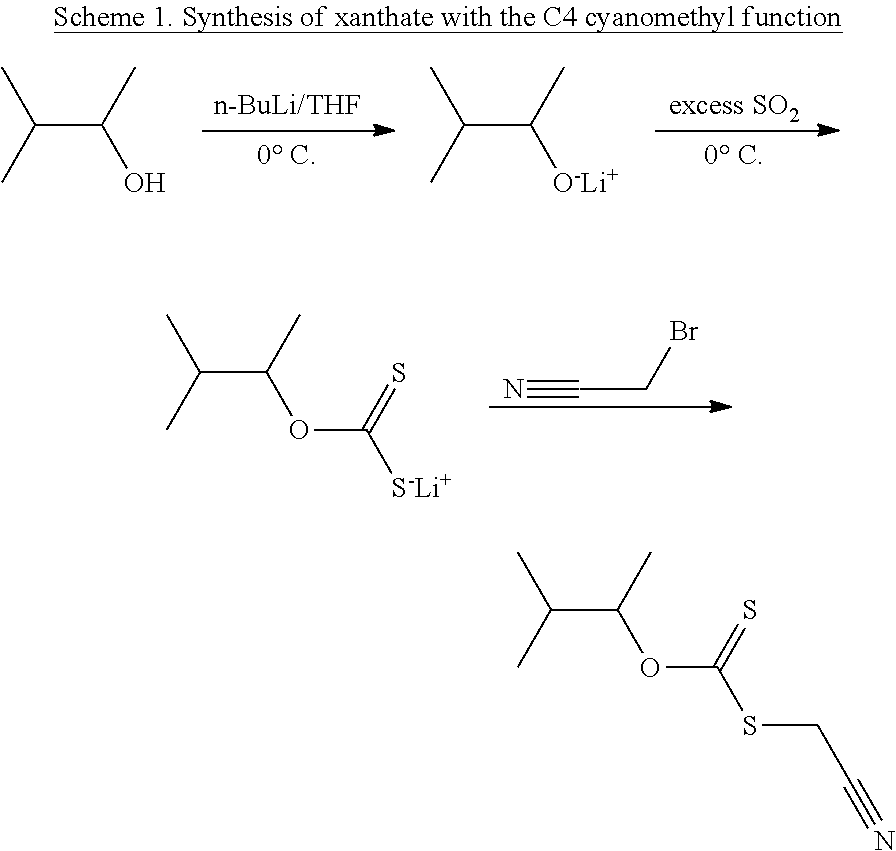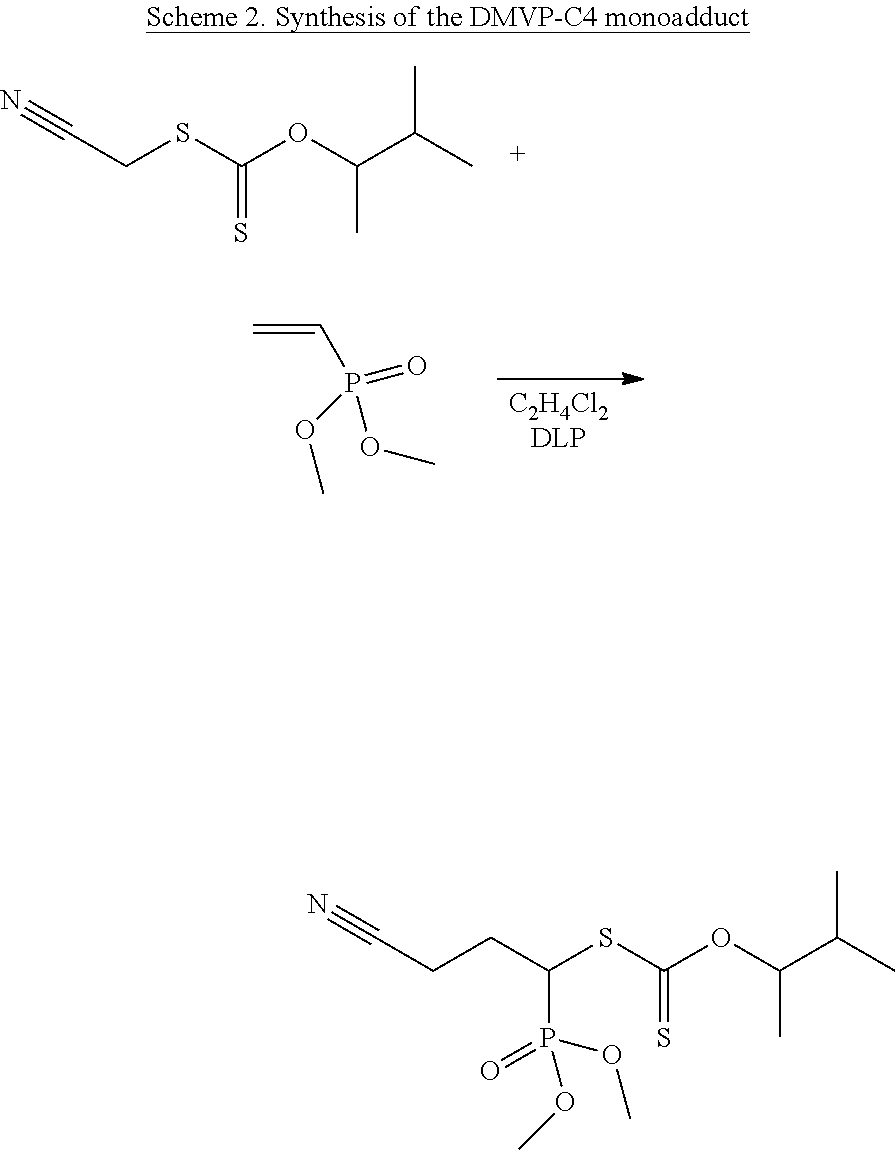Polyphosphorus polymer that is thiol-functionalised at the chain ends and production method thereof
a polyphosphorus polymer and functionalisation technology, applied in the field of polyphosphorus polymer that is thiolfunctionalised at the chain end, can solve the problems of lowering affecting the performance of the targeted application, and changing the macrostructure more significantly
- Summary
- Abstract
- Description
- Claims
- Application Information
AI Technical Summary
Benefits of technology
Problems solved by technology
Method used
Image
Examples
examples measurements
Used
[0099]The elastomers are characterized before curing, as indicated below.
[0100]Size-Exclusion Chromatography
[0101]The number-average molar masses Mn of the polymers, and also their dispersities, were obtained by size-exclusion chromatography (SEC) with tetrahydrofuran (THF) as eluent at 1 ml / min. Calibration is carried out with polystyrene standards (PS) having molar masses of between 1200 and 512 800 g·mol−1. The SEC chain is equipped with an RI Waters 2414 detector and a set of 2 columns (Shodex KF-802.5 and KF-804) thermostatically controlled at 35° C.
[0102]Glass Transition Temperature
[0103]The analyses for determining glass transition temperature were carried out with a Netzsch DSC apparatus (Phoenix).
[0104]An aluminium crucible comprising 5 to 10 mg of sample is placed on a platinum boat. The rate of temperature rise used for all the samples is 10° C.·min−1. The analyses were carried out under nitrogen.
[0105]Nuclear Magnetic Resonance Spectroscopy
[0106]1H NMR, 31P NMR and 1...
example 1
of a Xanthate with C4 Cyanomethyl Function
[0107]Reaction Scheme
[0108]6 g (6.81×10−2 mol) of 3-methylbutanol are dissolved in 45 ml of THF in a 500 ml round-bottomed flask. A solution of BuLi (1.6 M in hexane) (46.5 ml, 7.44×10−2 mol) is added dropwise to the reaction mixture at 0° C. The reaction is left, with stirring, for 30 minutes. Carbon disulphide (30 ml, 4.96×10−1 mol) is added dropwise to the reaction medium at 0° C. The reaction mixture is then maintained under magnetic stirring for 30 minutes at 0° C. 11.6 g (13.62×10−2 mol) of bromoacetonitrile is added dropwise to the reaction mixture, then the solution is kept under stirring for 15 h. After evaporating the THF, the residue is purified by CH2Cl2 water (1:1) extraction. The CH2Cl2 solution is evaporated under vacuum. After purification on a chromatography column (eluent: 95 / 5 petroleum ether / ethyl acetate) and evaporation, the product is obtained in the form of a yellowish oil with a final yield of 86%.
[0109]1H NMR (300 M...
example 2
of the Dimethyl Vinylphosphonate DMVP-C4 Monoadduct
[0111]Reaction Scheme
[0112]The C4 xanthete (2.76 g, 13.59×10−2 mol), the dimethyl vinylphosphonate (1 g, 7.35×10−3 mol) and the 1,2-dichloroethane solvent (6 ml) are introduced into a 25 ml round-bottomed flask surmounted by a reflux condenser. The mixture is degassed under argon for 15 minutes. The reaction mixture is then maintained at the reflux point of the solvent (95° C.) and under magnetic stirring for 7 hours. 5 mol % of dilauroyl peroxide are added every 60 minutes up to 25 mol %. After purification on a chromatography column (eluent: ethyl acetate) and evaporation, the final yield of the synthesis is 65%.
[0113]1H NMR (300 MHz, CDCl3, δ=ppm): 5.58 (1H, m, O—CHCH3), 4.35 (1H, m, NC—CH2—CH2—CH3—S—C═S), 3.82 (3H, s, P═(OCH3)2), 2.62 (2H, m, NC—CH2—CH2—CH1—S—C═S), 2.45-2.21 (2H, m, NC—CH2—CH2—CH1—S—C═S), 2.03 (—CH(CH3)2), 1.35 (3H, d, O—CHCH3), 0.95 (6H, d, (—CH(CH3)2).
[0114]31P NMR (300 MHz, CDCl3, 5=ppm): 24.6 (1P, d, P═(OCH3...
PUM
| Property | Measurement | Unit |
|---|---|---|
| hydrophilic | aaaaa | aaaaa |
| chemical | aaaaa | aaaaa |
| hydrophobic | aaaaa | aaaaa |
Abstract
Description
Claims
Application Information
 Login to View More
Login to View More - R&D
- Intellectual Property
- Life Sciences
- Materials
- Tech Scout
- Unparalleled Data Quality
- Higher Quality Content
- 60% Fewer Hallucinations
Browse by: Latest US Patents, China's latest patents, Technical Efficacy Thesaurus, Application Domain, Technology Topic, Popular Technical Reports.
© 2025 PatSnap. All rights reserved.Legal|Privacy policy|Modern Slavery Act Transparency Statement|Sitemap|About US| Contact US: help@patsnap.com



